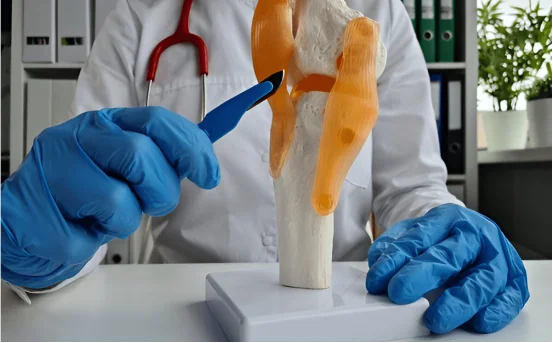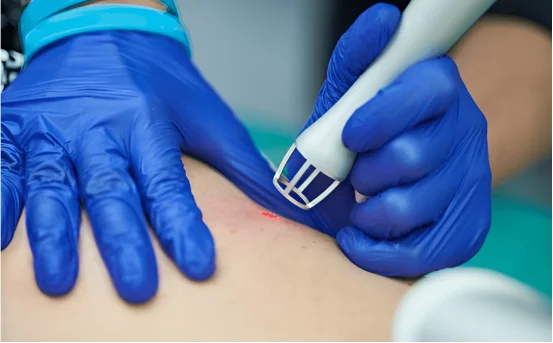An athlete’s knee injury, and a physically active person’s ailment, is a torn meniscus. The meniscus is made up of two C-shaped cartilages situated between the femur and tibia which acts as a shock absorber and minimizes friction when the knee joint bends. You can also face pain, swelling, and mobility issues if it is torn, either due to trauma or degeneration. Luckily, there are effective and advanced therapeutic modalities available to mend treatment of meniscus repair while restoring knee functionality as well as curtailing the risk of sustaining long-term joint damage.
What is a Meniscus Tear?
A meniscus tear can occur from sudden twisting motions or due to aging. These tears can be classified into two major groups:
- Traumatic Tears: The tears caused due to sports or accidents.
- Degenerative Tears: These are more common in elderly individuals, resulting from the thinning of cartilage.
Symptoms of a Meniscus Tear
- Knee pain that is sharp in nature
- Swelling and stiffness
- Catching or locking feeling in the knee
- Difficulty with flexion and extension of the knee
- Instability or “giving way” feeling
Understanding your symptoms is the first step in identifying the condition. Seeing a doctor in case of the above mentioned symptoms is essential to ensure that you get a reliable diagnosis and treatment.
For Diagnosis before treatment of the Meniscus repair, the following steps are likely to be taken:
For diagnosis, fixing a treatment plan requires conducting comprehensive tests and imaging including:
- Physical Examination: Joint line tenderness and movement should be assessed.
- MRI Scan: A detailed image of required soft tissue should be taken to confirm the tear.
- X-rays: Assess presence of fractures or arthritic changes in the bones.
With a confirmed meniscus tear, it is crucial that the grade and treatment of meniscus repair alongside how active the patient is, is factored in towards the method of treatment that is being recommended.
Stages of recovery differ from patient to patient, but not every case of treatment of meniscus repair necessitates surgery. Small grade tears towards the outer periphery of the meniscus (referred to as the ‘red zone’ which has good blood supply) may resolve on their own with appropriate conservative management.
- RICE Therapy
- Rest: Minimize weight bearing through the affected knee.
- Ice: Apply ice packs to the knee to minimize edema.
- Compression: Support the knee using an elastic bandage.
- Elevation: Keep the knee elevated to control inflamed tissues.
- Medications
Ibuprofen and naproxen are examples of medications that reduce inflammation and pain via action throughout the body.
- Physical Therapy
Physical therapy helps strengthen the muscles surrounding the knee, enhancing mobility and preventing further injuries. A specialized rehabilitation program consists of:
- Strengthening the quadriceps and hamstrings
- Balance training
- Gentle exercises, including swimming and cycling
For minor tears, these treatments will alleviate symptoms and enable patients to return to their normal routines in a matter of weeks.
Surgical Treatments for Meniscus Repair
Surgery becomes an option when non-surgical treatments don’t help, or when the tear is large, shifted, or situated in the “white zone” where blood flow is limited and therefore has poor circulation.
- Arthroscopic Meniscus Repair
This procedure is performed with a camera (arthroscope) viewing the knee through small incisions. These incisions will allow the surgeon to view the region and repair the tear. During the procedure, the surgeon stitches the torn pieces back together, maintaining as much cartilage as possible.
Benefits of Arthroscopic Meniscus Repair:
- Reduced scarring from smaller incisions
- Reduced length of hospital stay
- Reduced rehabilitation time
Lower degree knee damages and lesser chances of arthritis in the knee joint.
- Partial Meniscectomy
Now if the tear is irreparable, the surgery will revert to excising a greater portion of the meniscus. Recovery for this option is lower. However, there is an elevated risk to the progression of degeneration of the joint.
- Meniscus Transplantation
In more active younger individuals who have suffered significant damage, it may be possible to perform a meniscus transplant using allograft tissue. This is a more sophisticated operation and comes with additional criteria for inclusion.
Recovery After Meniscus Surgery
The recovery timeline is different for each surgery type:
- For Arthroscopic Meniscus Repair:
- First 2 weeks: Restricted mobility requiring the use of crutches as well as partial weight-bearing.
- 3-6 weeks: Physical therapy that incorporates strength and ROM progressions.
- 3-6 months: Resumption of all sports or demanding leisure activities.
- For Meniscectomy:
- 1-2 weeks: Reports of pain resolution and more range of motion.
- 4-6 weeks: Return to baseline function alongside physical therapy.
Post-operative Care Recommendations:
- Surgical instructions should be followed to the letter.
- Maintain the cleanliness and dryness of surgical incisions.
- Inactivity for high-impact sports is necessary until medical clearance.
- Strict adherence to the rehabilitation protocol is needed.
Meniscus surgery risks and complications
Despite the general safety treatment of meniscus repair procedures, the possible complications include:
- Infection
- Joint stiffness in the knee region
- Thromboembolic events
- Repair site tissue avascular necrosis
- Re-injury associated with high impact sports
These complications can be minimized through proper selection of the operating physician and adherence to rehabilitation and recovery guidelines.
Reducing the Risk of Meniscus Injuries
Even though some injuries are inevitable, here are some ways you can minimize your risk:
- Doing warm up exercises before engaging in physical activities
- Increasing strength in the leg muscles
- Making sure to have proper footwear for the sport being played
- Avoiding sudden twisting movements
- Keeping a healthy body weight to reduce stress on the knee
Conclusion
The type of treatment of meniscus repair is based on the specific details of the tear’s size, location, and severity, as well as the patient’s age and level of physical activity. Rest, medication, or physical therapy can be beneficial for minor injuries , while more serious issues are usually effectively treated with arthroscopic meniscus repair.
With prompt diagnosis and appropriate treatments, you can regain full knee function and return to your active lifestyle. If you are dealing with nagging knee pain or think you have a meniscus injury, it is best to see a specialist so that the most suitable, individualized treatment plan can be devised.























